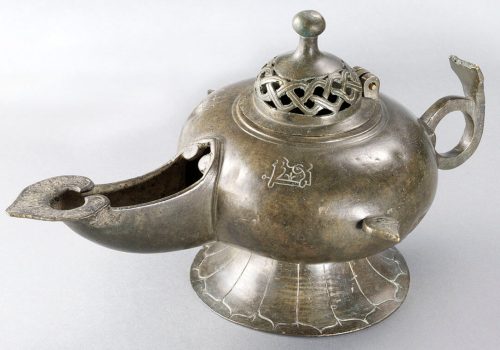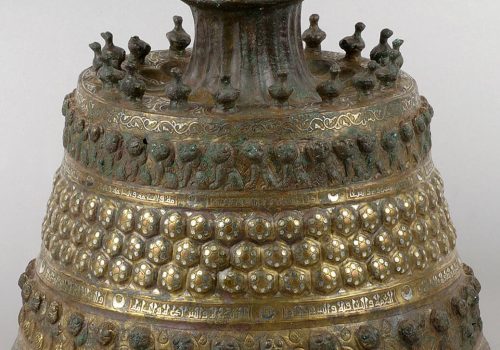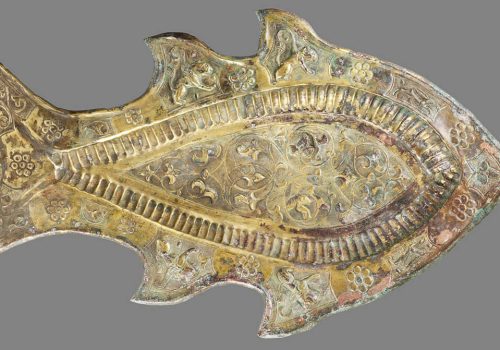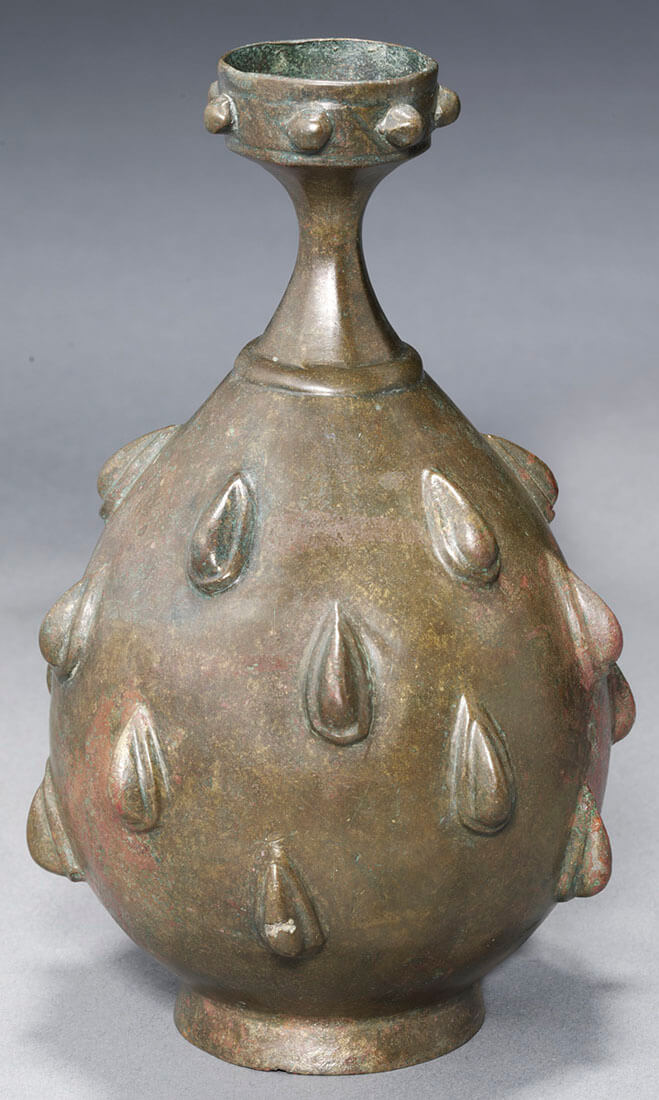Inv. no. LNS 28 M
Cast in openwork, chased, engraved and gilded
Diameter 6.4 cm; thickness 0.3 cm
Iranian world, 11th – 12th century AD
5th – 6th century AH
Metalwork
The al-Sabah Collection contains almost two thousand items of metalwork ranging from elaborately worked vessels inlaid with precious metals to simply cast bronze finials in the form of animals. Islamic metalworkers, whether in Cairo or Herat, often fashioned relatively simple forms covered the surface in dazzling engraved or precious metal-inlaid patterns of arabesque interlace, processions of animals or long benedictory inscriptions. Objects with calligraphy as decoration occur more frequently in metalwork than any other medium used for objects of utility. These range from benedictory inscriptions to verses from the Qur’an to lines of poetry, and sometimes include the signatures of the artists.
The ancient Near East has a long history of working in copper alloy and bronzes and brasses (copper alloyed with other metals) became the most important material in the pre-Islamic periods. Objects are almost invariably sculpturally powerful. In the hands of skilled artists, everyday objects such as oil lamps or incense burners became works of art. Brass was especially popular in the Mamluk domains. In the later period, especially in Iran and India, steel was used for decorative purposes; despite its hardness, it could be cut in openwork patterns, such as arabesques and calligraphic compositions as delicate as lace.

LNS 28 M
Gilded bronze belt or harness fitting with representation in openwork...

LNS 1218 M
Bronze incense burner in the form of a stylized feline,...

LNS 1218 M
Bronze incense burner in the form of a stylized feline, cast in intricate openwork to release the incense, with inlaid faience and glass eye, the tail terminating in a floral and avian plaque, the hinged head and neck serving as the lid
Inv. no. LNS 1218 M
Cast in openwork, chased and engraved, the eyes inlaid with light turquoise-glazed faience, the latter inlaid with a thin slab of turquoise-coloured glass
Height 26.5 cm; length 26.6 cm
East Iranian world, 11th – 12th century AD
5th – 6th century AH
You can share this object via:

LNS 939 M
Bronze incense burner, the openwork body and lid suggesting a...

LNS 939 M
Bronze incense burner, the openwork body and lid suggesting a domed building, the feet those of a quadruped; inscribed in Kufic script, ‘Blessing to Abi [I]shaq bn ‘Isa, may God prolong his glory’
Inv. no. LNS 939 M
Cast, chased, pierced and engraved
Height 29 cm; width 19 cm
East Iranian world, 10th – 11th century AD
4h – 5th century AH
You can share this object via:

LNS 293 M
Parcel gilt bronze divining bowl (central post and rotational element...

LNS 293 M
Parcel gilt bronze divining bowl (central post and rotational element lost), the interior with stellate layout; covered with inscriptions, including passages from the Qur’an, invocations to the twelve Shi‘a imams and inscriptions and numbers of talismanic character; signed and dated by the maker, Husayn Shakani; inscribed after manufacture with an owner’s name, ‘Halim Bayg’
Inv. no. LNS 293 M
Cast, with lathe-cut details, engraved and gilded
Height 7.5 cm; diameter 22.8 cm
India, probably Hyderabad, dated 956 AH/1549-50 AD
You can share this object via:

LNS 804 M
Bronze oil lamp with domical lid featuring an openwork plait...

LNS 804 M
Bronze oil lamp with domical lid featuring an openwork plait design, a leaf-shaped spout, and a Kufic inscription wishing ‘Blessing and happiness’ to its owner
Inv. no. LNS 804 M
Cast in sections, chased, soldered, pierced and engraved
Height 14.2 cm; width 26 cm
East Iranian world, ca. 10th century AD
ca. 4th century AH
You can share this object via:

LNS 110 M
Brass basin inlaid with silver featuring thuluth inscriptions lauding an...

LNS 110 M
Brass basin inlaid with silver featuring thuluth inscriptions lauding an (unnamed) officer of al-Malik an-Nasir Muhammad ibn Qala’un (r. 693-741 AH/1293-1341 AD, with interruptions), ogives and roundels with flying ducks, and vegetal motifs; later owner’s inscription, one ‘Abd Allah ibn Ahmad)
Inv. no. LNS 110 M
Hammered from sheet, engraved and inlaid
Height 22.2 cm; diameter 48.3 cm
Egypt or Syria, 1st half 14th century AD
1st half 8th century AH
You can share this object via:

LNS 82 M
Bronze candlestick inlaid with copper and silver, with salient rows...

LNS 82 M
Bronze candlestick inlaid with copper and silver, with salient rows of ducks and seated lions, and invocations of good wishes to the owner in Kufic script
Inv. no. LNS 82 M
Raised and fabricated from sheet and worked in repoussée, engraved and inlaid
Height 31 cm; diameter 33 cm
East Iranian world, late 12th – early 13th century AD
late 6th – early 7th century AH
You can share this object via:

LNS 104 M
Combined silver folding spoon and fork inlaid with niello, with...

LNS 104 M
Combined silver folding spoon and fork inlaid with niello, with pious inscriptions in Kufic invoking God, and with vegetal arabesques and representations of simurghs and birds
Inv. no. LNS 104 M
Cast, engraved and inlaid with niello
Length 14.8 cm; width 3.2 cm
Iranian world, 12th century AD
6th century AH
You can share this object via:

LNS 1136 M a
Bronze dish in the form of a fish (for the...

LNS 1136 M a
Bronze dish in the form of a fish (for the serving of fish?), decorated with winged lions, hares, seven-circle rosettes, flutes and a vegetal arabesque
Inv. no. LNS 1136 M a
Hammered from sheet and worked in repoussé
Length 44 cm; width 26.3 cm
East Iranian world, 12th century AD
6th century AH
You can share this object via:

LNS 1052 M a,b
Reticulated bronze lamp, with: mounted riders hunting with felines and...

LNS 1052 M a,b
Reticulated bronze lamp, with: mounted riders hunting with felines and falcons; representations of the twelve signs of the zodiac and the seven planets, all identified by their names; and good wishes to the owner, all in Kufic script
Inv. no. LNS 1052 M a,b
Cast in openwork and engraved
Height 31.2 cm; diameter 21 cm
East Iranian world, ca. 11th century AD
ca. 5th century AH
You can share this object via:

LNS 992 M
Reticulated double-walled bronze bottle with bands of undulating half-palmette scrolls,...

LNS 992 M
Reticulated double-walled bronze bottle with bands of undulating half-palmette scrolls, and a prominent band with good wishes to the owner in Kufic script
Inv. no. LNS 992 M
Cast in openwork and engraved
Height 22 cm; diameter 13.7 cm
East Iranian world, ca. 11th century AD
ca. 5th century AH
You can share this object via:

LNS 409 M
Bronze incense burner (lid missing) decorated in openwork with scrolling...

LNS 409 M
Bronze incense burner (lid missing) decorated in openwork with scrolling vines, and with handle finial in the form of a poppy fruit
Inv. no. LNS 409 M
Cast in openwork and engraved
Height 7.6 cm; length 28.5 cm
East Iranian world, 9th – 10th century AD
3rd – 4th century AH
You can share this object via:

LNS 608 M
Bronze perfume sprinkler decorated with staggered rows of buds...

LNS 36 M
Brass planispheric astrolabe (the earliest known Islamic example), signed by...

LNS 36 M
Brass planispheric astrolabe (the earliest known Islamic example), signed by Muhammad ibn ‘Abdallah (known as ‘Nastulus’) and dated in Arabic letters (abjad numeration) to 315 AH
Inv. no. LNS 36 M
Cast and engraved
Height 22.3 cm; diameter 17.7 cm
Iraq, probably Baghdad, dated 315 AH/927-28 AD
You can share this object via:

LNS 1338 M
Bronze ewer with spirally ribbed body, one rib with a...

LNS 1338 M
Bronze ewer with spirally ribbed body, one rib with a single diminutive scroll. The handle’s ‘thumbrest’ in the form of a palmette, its base terminated by a stylized antelope head
Inv. no. LNS 1338 M
Body and handle separately cast, chased and engraved
Height 38 cm; width 17 cm
East Iranian world, 8th – 9th century AD
2nd – 3rd century AH
You can share this object via:

